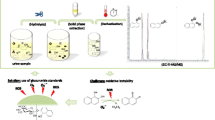Abstract
Male Wistar rats were exposed ton-hexane concentrations between 50 and 3000 ppm for 8 h, and urinary excretion kinetics of then-hexane metabolites 1-hexanol, 2-hexanol, 3-hexanol, 2-hexanone, 2,5-hexanedione, and 4,5-dihydroxy-2-hexanone were assessed. The amounts of metabolites excreted were linearly dependent on then-hexane exposure concentration, up to an exposure of about 300 ppm. Above 300 ppm exposure the metabolite excretion indicated saturation kinetics in the metabolism ofn-hexane. In its quantity, the newly described 4,5-dihydroxy-2-hexanone was the second metabolite, its amount in the urine being about ten times higher than that of excreted 2,5-hexanedione. Using gas chromatography-mass spectrometry the occurrence of 4,5-dihydroxy-2-hexanone as ann-hexane metabolite in urine of man was confirmed after exposure of a male volunteer to a mean of 217 ppmn-hexane for 4 h (laboratory exposure). Twenty-six hours after starting this exposure the excretion of 4,5-dihydroxy-2-hexanone (as a result of then-hexane exposure) reached a level which was four times higher than the excretion of 2,5-hexanedione. The results in both rat and man indicate the relevance of 4,5-dihydroxy-2-hexanone as a metabolite ofn-hexane metabolism. Formation of this metabolite may be viewed as a route of detoxification.
Similar content being viewed by others
References
Abou-Donia MB, Makkawy H-AM, Graham DG (1982) The relative neurotoxicities ofn-hexane methyln-butyl ketone, 2,5-hexanediol, and 2,5-hexanedione following oral or intraperitoneal administration in hens. Toxicol Appl Pharmacol 62: 369–389
ACGIH (1986) In: Documentation of the threshhold limit values and the biological exposure indices, 5th edition, p. BEI-15-17 American Conference of Governmental Industrial Hygienists, Cincinnati, Ohio, USA
Altenkirch H, Mager J, Stoltenburg G, Helmbrecht J (1977) Toxic polyneuropathies after sniffing a glue thinner. J Neurol 214: 137–152
De Caprio AP, O'Neill EA (1985) Alterations in rat axonal cytoskeletal proteins induced by in vitro and in vivo 2,5-hexanedione exposure. Toxicol Appl Pharmacol 78: 235–247
DiVincenzo GD, Kaplan CJ, Dedinas J (1976) Characterization of the metabolites of methyln-butyl ketone, methyl iso-butyl ketone, and methyl ethyl ketone in guinea pig serum and their clearance. Toxicol Appl Pharmacol 36: 511–522
DiVincenzo GD, Hamilton ML, Kaplan CJ, Dedinas J (1977) Metabolic fate and disposition of14C-labeled methyln-butyl ketone in the rat. Toxicol Appl Pharmacol 41: 547–560
Fedtke N, Bolt H (1986a) Methodological investigations on the determinations ofn-hexane metabolites in urine. Int Arch Occup Environ Health 57: 149–158
Fedtke N, Bolt HM (1986b) Detection of 2,5-hexanedione in the urine of persons not exposed ton-hexane. Int Arch Occup Environ Health 57: 143–148
Fedtke N, Bolt HM (1987) 4,5-Dihydroxy-2-hexanone: a new metabolite ofn-hexane and of 2,5-hexanedione in rat urine. Biomed Environ Mass Spectrom (in press)
Frommer U, Ullrich V, Staudinger H-J (1970) Hydroxylation of aliphatic compounds by liver microsomes, I: the distribution pattern of isomeric alcohols. Z Physiol Chem 351: 903–912
Frommer U, Ullrich V, Staudinger H-J (1972) The monooxygenation ofn-heptane by rat liver microsomes. Biochem Biophys Acta 280: 487–494
Frommer U, Ullrich V, Orrenius S (1974) Influence of inducers and inhibitors on the hydroxylation pattern ofn-hexane in rat liver microsomes. FEBS Lett 41: 14–16
Genter MB, Szakal-Quin G, Anderson CW, Anthony DC, Graham DG (1987) Evidence that pyrrole formation is a pathogenic step in γ-diketone neuropathy. Toxicol Appl Pharmacol 87:351–362
Herskowitz A, Ishii N, Schaumburg H (1971) n-Hexane neuropathy: a syndrome occuring as a result of industrial exposure. N Engl J Med 285: 82–85
Iwata M, Takeuchi Y, Hisanaga N, Ono Y (1983a) A study on biological monitoring of n-hexane exposure. Int Arch Occup Environ Health 51: 253–260
Iwata M, Takeuchi Y, Hisanaga N, Ono Y (1983b) Changes ofn-hexane metabolites in urine of rats exposed to various concentrations of n-hexane and to its mixture with toluene or MEK. Int Arch Occup Environ Health 53: 1–8
Krasavage WJ, O'Donoghue JL, DiVincenco GD, Terhaar CJ (1980) The relative neurotoxicity of methyln-butyl etone,n-hexane and their metabolites. Toxicol Appl Pharmacol 52: 433–441
Mutti A, Falzoi M, Lucertini S, Arfini G, Zignani M, Lombardi S, Franchini I (1984)n-Hexane metabolism in occupationally exposed workers. Br J Ind Med 41: 533–538
Perbellini L, Brugnone F, Pastorello G, Grigolini L (1979) Urinary excretion ofn-hexane metabolites in rats and humans. Int Arch Occup Environ Health 42: 349–354
Perbellini L, Brugnone F, Faggionato G (1981a) Urinary excretion of the metabolites ofn-hexane and its isomers during occupational exposure. J Ind Med 38: 20–26
Perbellini L, Brugnone F, Silvestri R, Gafturi E (1981b) Mesurement of the urinary metabolites ofn-hexane, cyclohexane and their isomers by gas chromatography. Int Arch Occup Environ Health 48: 99–106
Perbellini L, Amantini MC, Brugnone F, Frontali N (1982) Urinary excretion ofn-hexane metabolites. A comparative study in rat, rabbit and monkey. Arch Toxicol 50: 203–215
Perbellini L, Tagliaro F, Maschio S, Zedde A, Brugnone F (1986) Dossagio gas-chromatographico del 2,5-esandione nelle urine. Med Lav 77: 628–634 (Italian with English summary)
Schaumburg HH, Spencer PS (1976) Degeneration in central and peripheral nervous systems produced by puren-hexane: an experimental study. Brain 99: 183–192
Towfighi J, Gonatas NK, Pleasure D, Cooper HS, McCrea L (1976) Glue sniffer's neuropathy. J Neurol 26: 238–243
White EL, Bus JS, Heck H d'A (1979) Simultaneous determination ofn-hexane, 2-hexanone and 2,5-hexanedione in biological tissues by gas chromatography mass spectrometry. Biomed Mass Spectrom 6: 169–172
Yamada S (1967) Intoxication polyneuritis in the workers exposed ton-hexane. Jpn J Ind Health 9: 651 (Japanese with English summary)
Author information
Authors and Affiliations
Rights and permissions
About this article
Cite this article
Fedtke, N., Bolt, H.M. The relevance of 4,5-dihydroxy-2-hexanone in the excretion kinetics ofn-hexane metabolites in rat and man. Arch Toxicol 61, 131–137 (1987). https://doi.org/10.1007/BF00661371
Received:
Accepted:
Issue Date:
DOI: https://doi.org/10.1007/BF00661371




